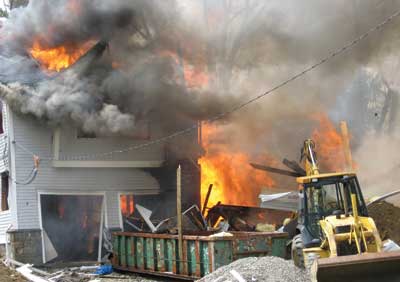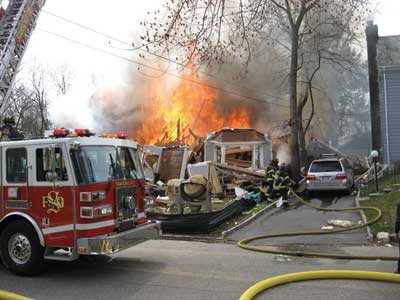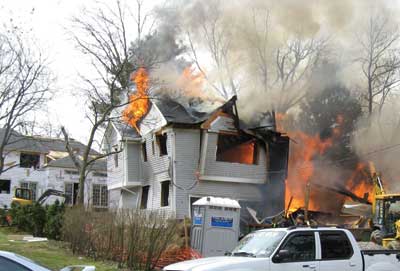By DANIEL PURCELL
What was dispatched as another routine call could have turned deadly for the Scarsdale (NY) Fire Department (SFD) and several construction workers if not for ongoing cooperation and training the SFD received from Consolidated Edison (ConEd), the region’s gas and electric utility company, and placing that training into action.
On April 3, 2008, at 1408 hours, the SFD dispatched the standard assignment of two engine companies and a command vehicle to a civilian report of an outside odor of natural gas at 60 Fayette Road in the village of Scarsdale. On arrival, the incident commander (IC) found a new, nearly completed, 4,900-square-foot, wood-frame private dwelling with a contractor operating a backhoe in the front yard and several laborers standing nearby on the spoil pile.
On exiting his vehicle, the IC heard the loud hiss of natural gas escaping from the high-pressure house service gas supply line at the site where the backhoe and laborers were still operating. The IC’s aide moved the command vehicle to a safer distance, and the incoming fire companies were ordered to stop two doors down from the scene. The IC, from the corner of the property, shouted and gestured to the backhoe operator to shut off the machine and get away from the gas leak.
As the workers moved from the property and onto the street and incoming fire companies dismounted their apparatus, the house exploded with an ensuing heavy fire. An immediate roll call ensured that all SFD members were accounted for and uninjured and all the construction workers were safe and uninjured. Photo 1 shows the close proximity of the backhoe and spoil pile to the house where the laborers were working moments before the explosion.
 |
| (1) Photos by Peter Zielinski. |
Prior to receiving this alarm, the SFD, the Eastchester (NY) Fire Department (EFD), and the Hartsdale (NY) Fire Department (HFD) had been conducting joint hazardous materials technician refresher training with instructors from the New York State Office of Fire Prevention and Control at Scarsdale Station 3, three blocks from the reported gas leak. On hearing the explosion and fearing the worst, the SFD, the EFD, and the HFD firefighters who had remained at the training site notified dispatch and responded. EFD Captain Thomas Ferrara was preparing to assume command and coordinate a search for missing or dead firefighters. He was surprised to find the SFD captain alive and uninjured, directing the placement of the initial 2½-inch handlines by SFD firefighters. “I saw the IC standing in a cloud of smoke in the street. Relieved that he was alright but still convinced of the worst, I went to him immediately and asked how many guys he had lost, expecting to hear three or four. When he said he had everybody—his own men and the civilian workers—I was shocked.”
EFD firefighters, who were attending the hazmat tech refresher class without accompanying apparatus, were directed to stretch a 2½-inch handline from second-due SFD Engine 57 to protect exposure D, a 2½-story wood-frame private dwelling approximately 12 feet from the heavily involved remains (photo 2). Ultimately, it was determined that exposure D sustained structural damage from the impact of the blast but, because of the efforts of the protecting hose team, no fire or heat damage.
 |
| (2) |
HFD Captain Joseph Kelley directed his firefighters to position their Engine 170 on the parallel street (Lebanon Road) to protect exposure C (photo 3). This exposure was a 5,000-square-foot, wood-frame private dwelling also under construction, with no windows installed, and the newly placed Tyvek® was exposed to the heat from the fire. HFD firefighters were able to protect exposure C and deploy a master stream onto the rear of the fire building. SFD Tower Ladder 29 also arrived on scene from the training session and was placed in operation in front of the fire building operating two master streams. Photo 4 shows the exchange of information between the first-arriving officer and the arriving chief who assumed command and the early volume of fire as the tower ladder is being placed into operation.
 |
| (3) |
 |
| (4) |
The investigation determined that the backhoe pulled the gas supply line from the house. Although a utility markout had been performed as required by law, the spoil pile was placed on top of the markouts. Escaping gas from the 62-pound-per-square-inch house supply line entered the structure through the hole in the building’s foundation, created when the gas line was pulled. The location of the ignition was confirmed to be in the basement of the structure, but the exact source of the ignition was undetermined.
Lessons learned from this incident include the following:
- Always avoid complacency. Apparatus and firefighters were kept at a safe distance, fearing an explosion could occur. When it did, the IC quickly accounted for all fire department personnel.
- Once all human lives are verified as being safe, focus all efforts on containing the fire. The foreman quickly accounted for his civilian laborers by gathering them in a neighboring front yard.
- Having the fast response of the additional personnel who responded from the training session was instrumental in confining the fire to the structure of origin. The SFD is a combination department normally staffed with two career members on each engine company. The importance of the additional 12 firefighters arriving on scene within moments of the explosion cannot be diminished.
- Proper training limited the damage to the exposures to blast damage only; no fire damage was sustained. Two-and-a-half-inch handlines were initially stretched.
- Use of the incident command system again showed its value in keeping a chaotic scene organized. Once the chief arrived and assumed command, the captain who had arrived at the onset of the alarm was placed in charge of operations, and subsequent arriving officers were detailed to safety and as liaisons with the mutual-aid companies.
- Communication with the mutual-aid companies was hampered by different fireground radio frequencies. Attempts are being made to ensure that all neighboring departments have the Scarsdale fireground frequencies programmed into their radios, and vice versa.
- All departments should develop and maintain a relationship with their local utility company. ConEd has made significant efforts to improve responses to emergencies and bolster its rapport with emergency responders. One of these efforts has been in providing fire departments with training on how to respond to emergencies involving electrical power lines and natural gas emergencies. Newly appointed career officers in New York State attend the First Line Supervisor Training Program at the Fire Department of New York in New York City and ConEd gives a presentation on the dangers of high-voltage electrical line emergencies and the dangers of natural gas leaks. ConEd’s emergency response personnel also train individual departments on request. This training was paramount to this incident’s success.
DANIEL PURCELL is a 25-year member and captain for the Scarsdale (NY) Fire Department. He is also a paramedic. Purcell has an associate degree in math and science from Westchester Community College.
More Fire Engineering Issue Articles
Fire Engineering Archives

